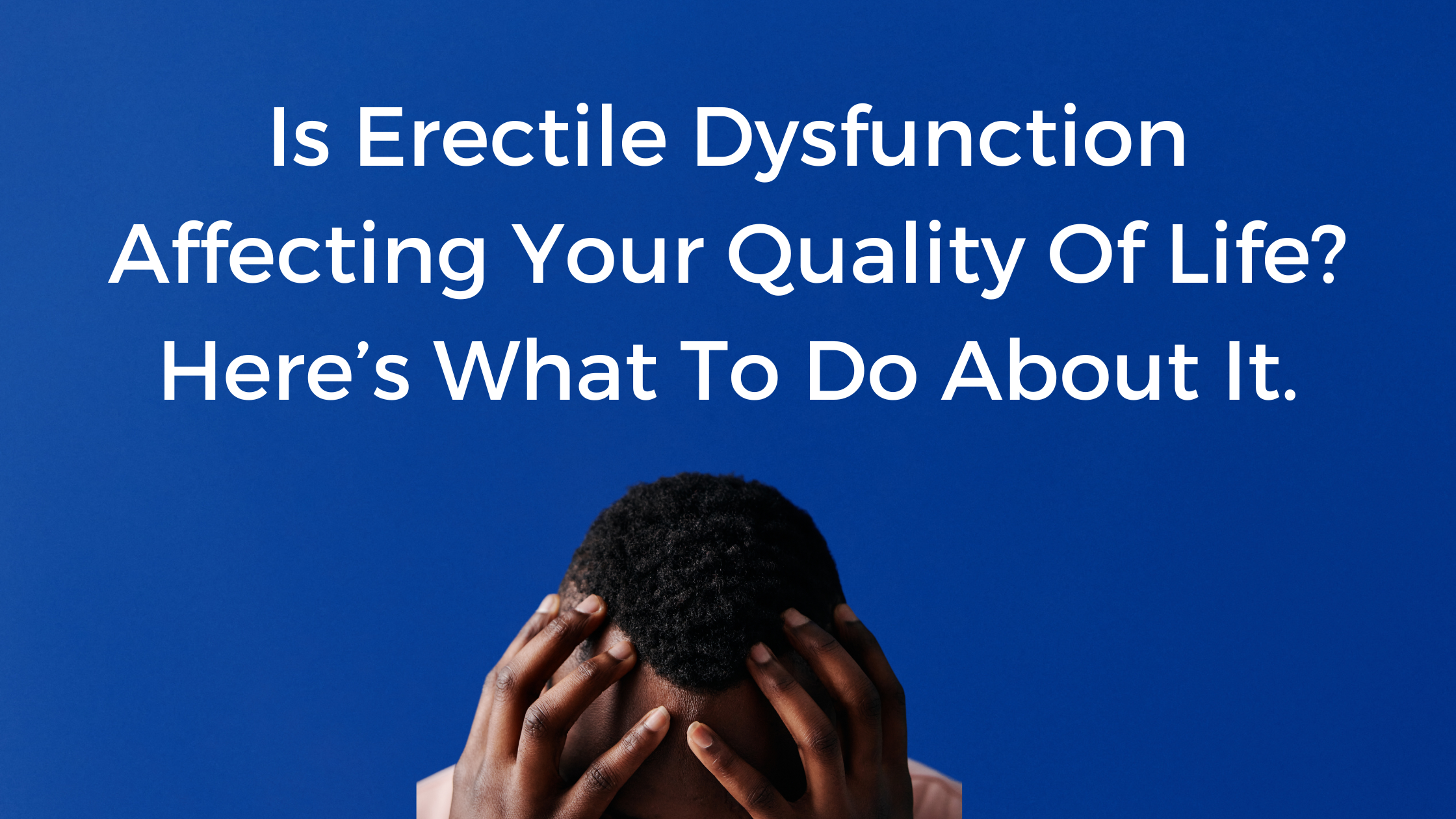Erectile dysfunction isn’t an easy topic to talk about, let alone admit to oneself. Although, it shouldn’t be taboo considering how common it is. Estimates for the condition for men of all ages across the world range from 23% to 52% according to various studies.
Recent research on Canadian men aged 40 to 80 years found that the overall prevalence of erectile dysfunction was 49.4%–almost half the population in that age group!
In fact, ED is no longer classified as a disease of old age; large studies conducted globally have estimated the prevalence of ED in young men to be as high as 30%.
Despite the growing number of studies, discussing ED remains stigmatizing due to several social and cultural factors. However, this should absolutely not be a barrier to seeking treatment to improve your quality of life. Recognizing the signs and symptoms of ED and addressing the causes behind them is the first step in treating the condition.
Defining Erectile Dysfunction

Simply put, erectile dysfunction is a condition in which you are unable to get an erection or to maintain an erection that is firm enough for satisfactory sexual intercourse. There are various degrees of ED. You can have ED if:
- You get an erection sometimes, but not every time you have sex
- You can get an erection, but it does not last long enough for fulfilling or satisfying sex
- You never get an erection
As per the Diagnostic and Statistical Manual of Mental Disorders, Fifth Edition (DSM-5), for a clinical diagnosis of erectile dysfunction, certain criteria need to be met:
- During around 75-100% of sexual activities, experiencing at least one of the following: marked difficulty in obtaining an erection, marked difficulty in maintaining an erection until the completion of sexual activity, or marked decrease in erectile rigidity.
- The symptoms above have lasted for around 6 months
- The symptoms above cause significant distress to the individual
- The dysfunction cannot be better explained by a nonsexual mental disorder, a medical condition, the effects of a drug or medication, severe relationship distress, or other significant stressors
What Can Cause Erectile Dysfunction?
ED is a complex condition that can involve several causes, ranging from psychosocial and circumstantial to medical reasons and substance use.
Medical conditions that can cause ED are:
- Atherosclerosis
- Obesity
- Hyperlipidemia
- Hypertension
- Diabetes
- Metabolic Syndrome
- Stroke
- Pelvic Trauma
Psychosocial causes of ED include:
- Depression
- Anxiety
- Partner-Related Difficulties
- Performance Anxiety
- History Of Sexual Abuse
Drugs, including recreational substances and medications, that can lead to ED are:
- Antihypertensives
- Antiandrogens
- Antidepressants
- Alcohol
- Tobacco
- Opioids
Treatment Options for Erectile Dysfunction
Lifestyle changes
The first approach to treating ED is usually non-pharmacological, depending on the degree of dysfunction. Making lifestyle changes such as exercising more, losing weight, and eating a healthy, balanced diet is necessary whether or not your healthcare provider decides to prescribe you drugs.
Lifestyle factors also include substance use such as smoking and alcohol consumption. Both past and current cigarette smoking, and alcohol intake have dose-dependent associations with erectile dysfunction. According to research, the risk of ED also decreases with increasing physical activity.
Sexual counseling can also greatly help with ED, especially for those with ED due to psychological reasons.
Medical Therapy
First Line: Phosphodiesterase Type 5 Inhibitors
The second approach to ED treatment is medical therapy with phosphodiesterase type 5 inhibitors (PDE5Is), which are considered the first line pharmacological agents.
PDE5Is are oral drugs that enable penile erection by relaxing the vascular and cavernosal smooth muscle (penis erectile tissue) in response to sexual stimulation. They increase the blood flow to the penis during arousal leading to successful and lasting erections.
Health Canada has approved three PDE5Is for ED treatment: sildenafil (popularly known as Viagra), tadalafil (Cialis) and vardenafil (Levitra).
Sildenafil
- Dosage: 25 mg, 50 mg, 100 mg
- Works in: 1 hour
- Lasts: 4 to 12 hours
Tadalafil:
- Dosage: 2.5 mg, 5 mg, 10 mg, 20 mg
- Works in: 20 minutes
- Lasts: 24 to 36 hours
Vardenafil:
- Dosage: 2.5 mg, 5 mg, 10 mg, 20 mg
- Works in: 30 to 60 minutes
- Lasts: 5 to 7 hours
PDE5Is are the most commonly prescribed medicines for ED unless the patient is on nitroglycerin or organic nitrates.
A large, double-blind, placebo-controlled study of sildenafil therapy in Canadian men showed that 77.3% of men in the sildenafil group reported an improvement in their erections after 6 weeks of treatment compared with 22.7% in the placebo group. In the sildenafil group, 75.3% of men reported improved intercourse after 6 weeks of treatment compared with 24.7% of those in the placebo group.
In another study in Canada, between 50% to 62% of ED patients treated with tadalafil were able to have successful sexual intercourse after their first dose.
Maximum dosage of any of sildenafil, tadalafil, and vardenafil has shown to improve erectile function by 7- 10 points on the International Index of Erectile Function (IIEF) questionnaire.
PDE5Is are safe and well-tolerated according to the results of several trials.
Potential side effects some men might experience to the three drugs include:
- headache
- flushing
- dyspepsia
- nasal congestion
Drug-specific side effects include changes in color vision for sildenafil and vardenafil, and myalgia (muscle pain) for tadalafil.
Patients who don’t respond to PDE5Is may need counseling on the correct use of the drug and or a dose adjustment.
Second line: Intraurethral alprostadil, Vacuum Erection Pump Devices, Intracavernosal Injection
Intraurethral and Intracavernosal Injection:
Intraurethrally applicated alprostadil or the medicated urethral system for erection (MUSE) is the application of alprostadil (prostaglandin E1) to improve vasodilation and thus blood flow to the penis.
Basically, it is a urethral suppository (intraurethral alprostadil) or injection (intracavernosal) to the penis usually first given by a doctor to demonstrate how to administer it. It can later be self-administered at home; however, it needs to be done properly to avoid damage to the penis.
Trials have shown efficacy increased from 45.8% after the first application, 63.7 % after the second, and to 69.3 % after the third application.
Side effects in order of decreasing frequency include:
- pain at the injection site
- bleeding
- painful erections
- erections lasting longer than 4 hours (priapism)
Intraurethral alprostadil is not approved by Health Canada as a treatment for ED.
Similarly, intracavernosal injection is the administration of papaverine (a vasodilator) or phentolamine (an alpha-adrenoceptor antagonist that eases blood flow), or a combination of the two with alprostadil into the penile tissue to treat ED. It is up to 89% effective in successful intercourse.
Vacuum Erection Pump:
A vacuum erection device or penis pump is an external device consisting of a plastic tube, pump attached to the tube, and a band that fits around the penis base. It is a cost-effective treatment for ED for those men that don’t respond to oral medications and don’t want to risk an invasive process for treatment.
Side effects of vacuum erection devices are:
- restricted ejaculation
- minor bruising
- pain during or after use
Third Line: Penile Prosthesis
This is a surgical option for ED, only considered after first-line and second-line treatments have been ineffective. Inflatable devices or flexible rods are implanted into the penis via surgery.
Studies have reported patient satisfaction rates of 85% with penile prostheses and a significant improvement in the quality of life.
Side effects are similar to those of any implant surgery:
- infection
- bleeding
- formation of scar tissue
- mechanical failures
- adhesions
What is the Most Efficient Treatment For ED?
With all the options available in the market, it is safe to say that the best treatment to help you with ED is sildenafil or tadalafil. And you can easily get a prescription from one of our physicians and have it delivered straight to your door in a discrete package.
Start your journey in regaining your confidence in the bedroom with a consultation today.
